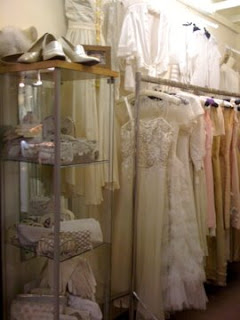There is something so exciting about a summer wedding; it can be one of the most beautiful times of the year to get married. Whether you are the bride or groom, bridesmaid or a guest looking for the perfect gift, Alfies is a great place to hunt around for all your wedding needs.
Vintage wedding dresses are so often intricately made and traditionally have such unusual detail and individual style. The dress can set the theme for the wedding and from the quiet elegance of the 1920’s to the glamorous 1950’s, you are sure to find something exquisite from Tony Durante’s extensive collection.
 He also has a fantastic array of accompanying bags and wedding shoes (such a tricky item to find!).
He also has a fantastic array of accompanying bags and wedding shoes (such a tricky item to find!).
 Pearls are a great summer choice for wedding jewellery. Think simple and understated to accompany your dress.
Pearls are a great summer choice for wedding jewellery. Think simple and understated to accompany your dress.
A deilicate seed pearl necklace with 5 strands. The clasp is in gold with diamonds, rubies and pearls.
Offered by Gareth Brooks
Something new? Why not try a new hairstyle courtesy of Nina’s Hair Salon and get spoilt in Isadora’s Pamper parlour for an afternoon or get your makeup done for the big day?
 They stock a large selection of hair accessories to enhance any wedding look. For a touch of sparkle, Persiflage has a range of elaborate tiaras.
They stock a large selection of hair accessories to enhance any wedding look. For a touch of sparkle, Persiflage has a range of elaborate tiaras. 
Pari's Jewellery also has this stunning pair of Topaz Earring, for that something blue!
A pair of 18kt white gold and blue topaz drop earrings.
Offered by Pari's Jewellery
Attending a wedding? For an individual look, brighten up your outfit with some beautiful summer accessories (The Originals - Paola & Iaia and Deborah Woolf Vintage to name a few) or better yet, find the perfect summer dress in ‘The Girl Can’t Help It’.
An usual bussle back cotton & pique spaghetti strap dress- size 10-12
My favourite thing about weddings is that it’s the perfect occasion to wear a hat. Both Tin Tin Collectables and June Victor have a wide variety of hats from the traditional to the quirky that you won’t be able to resist to try on for that special look.
A selection of June Victor's hats
Finally for the perfect gift.... From silver candlesticks to coffee spoons, Goldsmith & Perris have a large selection of silver for something traditional.
A pair of 20th Century silver column style candlesticks, Sheffield 1915
Offered by Goldsmith & Perris
If in doubt, let the bride and groom make the important decisions with some Alfies gift vouchers that will always go down a treat!








































